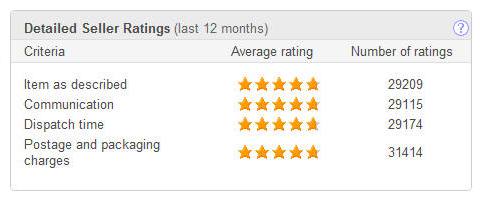In assessing the reliability of a seller, we recommend paying attention to the following indicators:
Number and ratio of positive and negative feedback. Example, if a seller has 10,000 reviews and say 80 of them are negative then his reputation will be 99.2%. We would say this seller is reliable. However, make sure you also check when the seller received most of his negative feedback. If they started receiving negative feedback recently, say within the last few weeks, then this could be an indicator that the service quality has recently dropped and buying from this seller may not be such a good idea.
Date of the seller’s registration in the system. The longer the seller has been operating on eBay, the better, although this parameter is worth taking into consideration only in connection with all other data.
Sales history. If you are planning on purchasing something expensive and the seller has a lot of feedback then it is always good to check what kind of items the seller has previously sold. As in this case you could say that a seller who has successfully sold 50 cars would be more reliable to purchase an expensive item from rather than a seller who has previously sold 1,000 buttons.
Feedback for the last month. When buying expensive items it makes sense to check and evaluate the seller’s activity and feedback on eBay for the last month. Current sales can be seen in the seller’s profile by clicking on the Items for sale link. If the seller has always sold inexpensive items and suddenly started selling TVs and laptops in the past week, it makes sense to closer explore his reputation.
Seller’s location. It so happens that the item is said to be located in the UK, but the seller is registered somewhere in China. This can lead to long delivery from China.
Always read the feedbacks. After eBay prohibited sellers to leave buyers negative feedback, many sellers started posting positive reviews with negative content. This is the only opportunity for the seller to leave bad feedback to a “bad” buyer. This buyer can turn out to be your seller, so it’s always useful to read the contents of the feedback. It’s also worth checking out the Detailed Seller Ratings. It is a small table that shows user feedback and rating based on four main criteria:
- Item as described
- Communication (quality of customer support)
- Dispatch time
- Postage and packaging charges
Example:

Hopefully, these tips will help you. The vast majority of sellers on eBay are decent and honest people, but better safe than sorry, as they say. If you have any questions on how to assess the reliability of an eBay seller – feel free to contact us!
